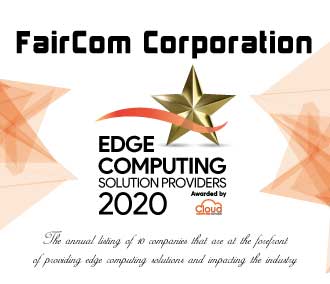 Mike Bowers, Chief Architect
Mike Bowers, Chief Architect There are many reasons why integrating data within the edge (at or near where data is produced) makes sense for mission-critical industry segments such as Industrial IoT (IIoT), and Industry 4.0. The most obvious advantages are high reliability, fast feedback, and reduced costs. Mission-critical processes require data collection and processing to be reliable and fast. As networks are not always reliable, there will be times in which devices on the edge cannot communicate across edges or with the cloud. In addition, network communications to the cloud are slowed by distance, which hinders real-time communications back to the edge. FairCom, a pioneer in the software industry, continues that reputation with IoT data integration, offering a fast and reliable data management platform specifically designed for edge networks, IoT, and IIoT environments. The product, c-treeEDGE, allows organizations to automatically collect, transform, store, process and integrate data in real time as it is produced. c-treeEDGE reliably provides real-time feedback to devices on the edge while delivering results to the cloud and other edge devices.
c-treeEDGE is optimized for edge-computing environments to serve the needs of factory automation, smart cities, medical device integration, and smart retail. The product is designed specifically for an individual device to collect, transform, store, process and integrate hierarchical data locally on the device or on a small industrial computer close to the device. Mike Bowers, Chief Architect at the FairCom says, “c-treeEDGE has predictable high-speed performance on constrained devices because it has a small footprint on disk and in RAM and works well on slow processors. Additionally, it works on all major operating systems, hardware, and languages. It processes any data: JSON, SQL tables, time series, binary, C structures, XML, and images. The product provides built-in integration with MQTT, REST, JSON/HTTP, OPC, PLC, Node-RED, ThingWorx, and SQL. Because of its automatic integration, transformation, collection, and processing capabilities, c-treeEDGE makes it easy for thousands of devices to work together to make real-time decisions on the edge.”
To give a bit more context, MQTT is the primary protocol for integrating IoT devices. A message may contain any type of data such as JSON, images, and binary structures. However, despite its importance, the MQTT protocol comes with a serious weakness.

Because of its automatic integration, transformation, collection, and processing capabilities, c-treeEDGE makes it easy for thousands of devices to work together to make local, real-time decisions on the edge
The protocol is not designed for storing and forwarding messages when the receiving devices are offline, which is a vital feature for mission-critical applications, including medical and manufacturing industries. As c-treeEDGE is a full-featured MQTT broker combined with an embedded database engine, it can send, receive, and forward MQTT messages even when receiving devices are offline. Unlike other MQTT brokers, it can automatically store, transform, and process data in MQTT messages. This makes c-treeEDGE ideal for mission-critical edge solutions where data must not be lost and needs to be processed on the edge in real time.
To make integration easy, c-treeEDGE provides intuitive graphical user interfaces and APIs. The user interfaces are browser based and built directly into c-treeEDGE. They make it easy to collect, transform, and integrate data automatically. They configure and monitor MQTT, transform and process JSON, create tables for automatic data collection, and query tables with SQL. The user interfaces and APIs allow users to replicate data across a mesh network of c-treeEDGE instances for high availability and parallel processing with minimal effort. And they monitor all aspects of c-treeEDGE.
Bowers explains how c-treeEDGE bridges the gap between programmable logic controller(PLC) programmers and IT programmers. The gap between PLC and PC is a showstopper for Industry 4.0 because data is locked into PLCs. Until recently there was no practical bridge between OT and IT. Siemens and Rockwell have now released IPC hardware solutions that simultaneously run PLC and PC operating systems, but hardware alone does not bridge the gap. c-treeEDGE completes the bridge by enabling PLC programmers to write code for the PLC side that directly reads and writes data to c-treeEDGE running on the PC side. Data from the PLC that is written into c-treeEDGE is immediately available to the rest of the factory through MQTT, HTTP, JSON, REST, SQL, and traditional programming languages. Conversely, data from IT and the rest of the factory can be written to c-treeEDGE and be instantly available for use by PLC code that automates factory equipment.
FairCom understands that in the future about 80 percent of data processing will move to edge computing. The company is prepared to leverage this shift by providing the most effective solution to collect, transform, store, process and integrate data across IoT devices and the cloud. With decades of experience, FairCom delivers exceptional products and services for their client’s data integration needs.
 Mike Bowers, Chief Architect
Mike Bowers, Chief Architect
